About
Special News
Logan's Page
Jacoby's Page
Our Travel Index
Tracks Ahead Related Trips
Contact
Netherlands, Tulips & Windmills River Cruise - 2011
Holland & Belgium
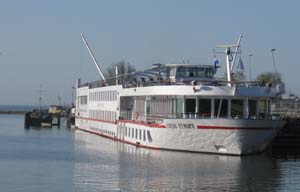 |
The good ship Viking Europe |
April 7
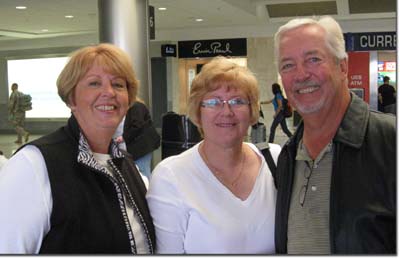 Bonnie,
Barb, Brian and I had the usual dreary plane ride from
Bonnie,
Barb, Brian and I had the usual dreary plane ride from
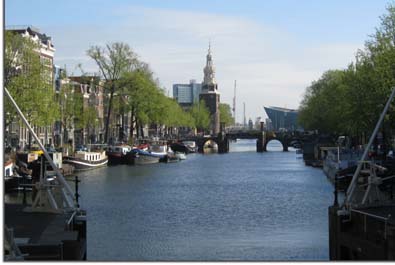
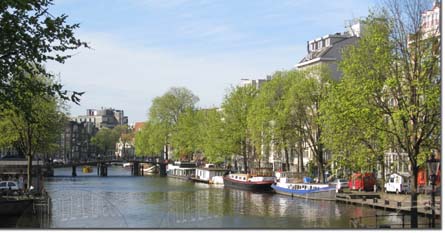
We hooked up with most of the rest of our
traveling companions at the hotel. We all thought that it was a
good idea to walk a bit to try to combat the jet lag.
The place is full of coffee houses, that will mix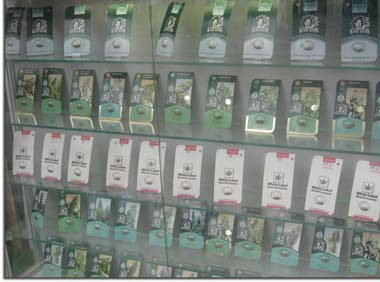 up whatever brew, as well as whatever high you want from legal
marijuana. The later is
readily available, and you can get custom mixes for whatever buzz you
want to experience. And you
can obtain a variety of seeds for your own personal herb garden back
home.
up whatever brew, as well as whatever high you want from legal
marijuana. The later is
readily available, and you can get custom mixes for whatever buzz you
want to experience. And you
can obtain a variety of seeds for your own personal herb garden back
home.
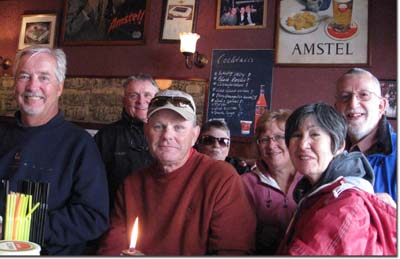 We
also discovered what had to be the cities smallest bar.
Needless to say, we had to have a beer or two.
Paul soon was best buddies with everyone in the place, including
Kevin, a former jockey from Newcastle.
Or so he said.
We
also discovered what had to be the cities smallest bar.
Needless to say, we had to have a beer or two.
Paul soon was best buddies with everyone in the place, including
Kevin, a former jockey from Newcastle.
Or so he said.
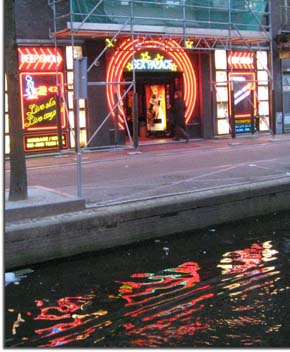 Of
course, we also had to take a stroll through the Red Light District,
purely on an exploratory
Of
course, we also had to take a stroll through the Red Light District,
purely on an exploratory
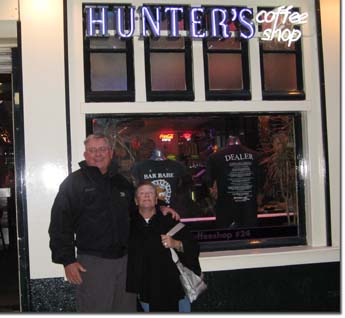 basis, you understand.
This place had to have been having an off night, as the area is
usually thronged with people.
basis, you understand.
This place had to have been having an off night, as the area is
usually thronged with people.
We discovered a particular coffee shop, that will have a special meaning to some from our group. Eventually the jet lag kicked in, and we headed back to the hotel to crash.
April 8
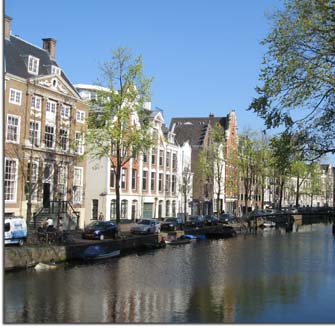 We
all slept well last night.
So it was up for the typical European breakfast and then out the door.
We started with a walking tour of old
We
all slept well last night.
So it was up for the typical European breakfast and then out the door.
We started with a walking tour of old
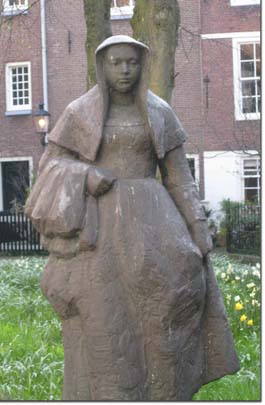 We
passed through a portion of the Begijnhof or cloister, which was originally a
cluster of small houses for pious, single women.
They could live here without husband or children, without becoming nuns,
at a time when there were few alternatives. In fact, single women
still live here.
Several things to note here. One is the Gebed Zonder End
alley, which means Prayer without End. The Dutch have adapted this
saying to slang for any event that goes on and on.
We
passed through a portion of the Begijnhof or cloister, which was originally a
cluster of small houses for pious, single women.
They could live here without husband or children, without becoming nuns,
at a time when there were few alternatives. In fact, single women
still live here.
Several things to note here. One is the Gebed Zonder End
alley, which means Prayer without End. The Dutch have adapted this
saying to slang for any event that goes on and on.
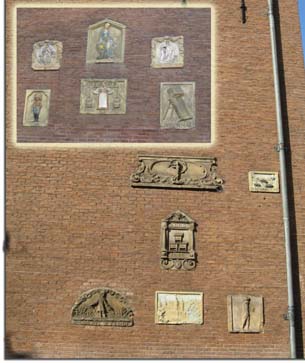
Also of interest were lintel stones set into a wall. These depicted the craft or trade of the house in olden times. Think of them as the first marketing tools.
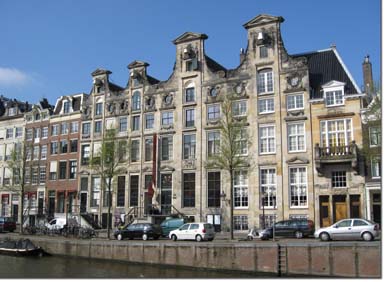
The walking tour pointed out some of the more expensive real estate (around €9,000/ sq meter) you do the math. There is a ten year wait for public housing, a small house costs around €200/250,000.
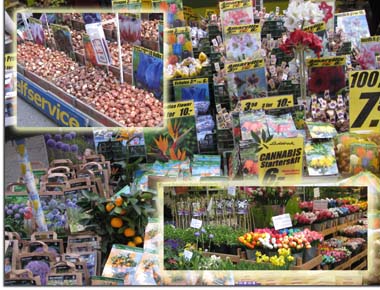
Our next stop was a walk through the tulip market. While there was plenty to see, including your very own cannabis sativa plaqnts, we all decided to wait until later in the trip.
We departed the end of the tour and took the streetcars down to
the
On to the train
station, the end of the streetcar line, and back on to another for a
ride back to the Dam area (where they originally dammed the
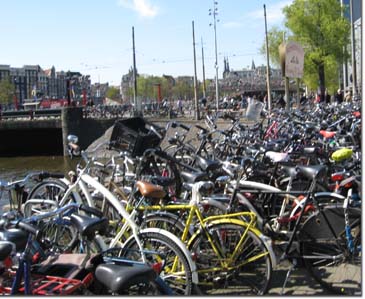 Did I mention that there are lots and lots of bikes.
People ride them everywhere.
I think we were told that while the city proper has a population of
around 80,000, there are 600,000 nicycles.
So the streets are equally shared by bikes, cars, and
pedestrians. The bikes all seem to
have the right of way, and will run over anything in their path, physics
be damned. Finally it was yet another short bar stop, and back to the
hotel, with dinner in a bit at a steak joint Paul had discovered.
Did I mention that there are lots and lots of bikes.
People ride them everywhere.
I think we were told that while the city proper has a population of
around 80,000, there are 600,000 nicycles.
So the streets are equally shared by bikes, cars, and
pedestrians. The bikes all seem to
have the right of way, and will run over anything in their path, physics
be damned. Finally it was yet another short bar stop, and back to the
hotel, with dinner in a bit at a steak joint Paul had discovered.
April 9
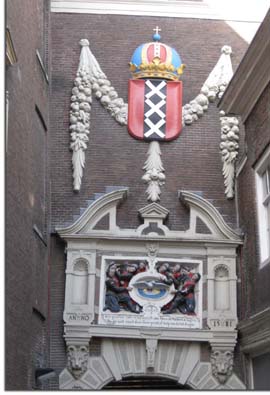 After a good nights rest, we were off to explore more of
After a good nights rest, we were off to explore more of
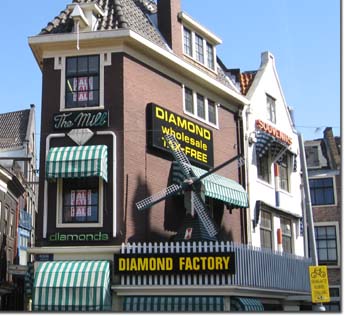
So far, this is the only wiondmill we have seen. The tulip market was yesterday. Is this the only windmill?
After we returned to the hotel, Brian and I headed out to scout
for a coffee house in which to spend a few hours.
We walked and walked, and by the time we found a place to sit,
there was no chance of returned for the group.
So he and I stayed, and solved the world’s problems, while the
rest of our entourage stayed in the hotel lobby and solved the problems
that the two of us failed to address.
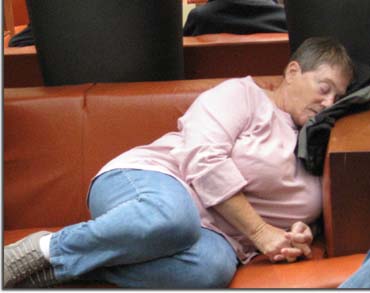
Then it was off to our floating home away from home (unpack once
and you’re good to go) the Viking Europe.
We had obligatory safety lecture, crew introductions, and dinner.
From that point we walked back into town, past the
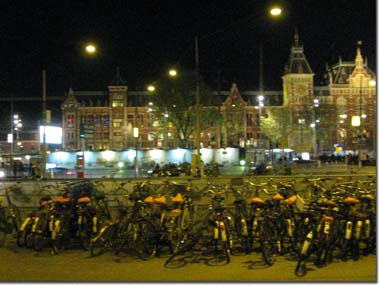 central
railway station, and to the Vistoria Hotel. This was to be the
start of a guided tour of
the Red Light District. Our guide turned out to be a woman from –
central
railway station, and to the Vistoria Hotel. This was to be the
start of a guided tour of
the Red Light District. Our guide turned out to be a woman from –
April 10
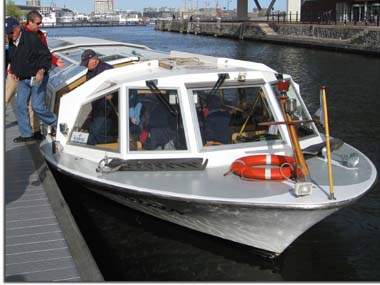 The
day started with a canal cruise, past many of the sights we had already
seen. There are no barriers on the
canal sides. The Dutch trust people to use their own good
judgement in how close to get to the edge. As a result, a few cars
end up in the water due to people misjudging parking areas.
The
day started with a canal cruise, past many of the sights we had already
seen. There are no barriers on the
canal sides. The Dutch trust people to use their own good
judgement in how close to get to the edge. As a result, a few cars
end up in the water due to people misjudging parking areas.
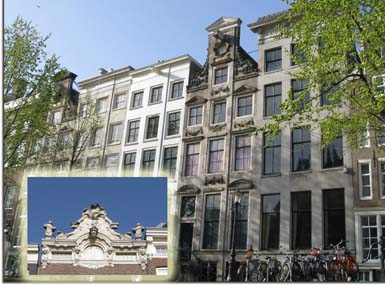
Some of the houses have ornate cornices, and if a house has a series of steps leading to the front door, tne builder must have been very wealthy.
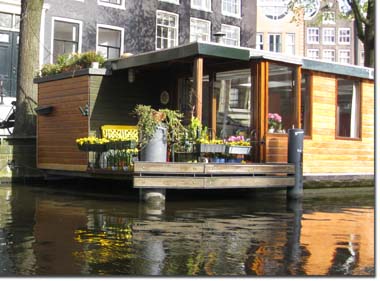
There are about 2,400 houseboats that are moored along the canals are taxed as residences. If a houseboat sinks or moves, another may not occupy its spot, as the city is trying to get rid of them. Many are in poor repair.
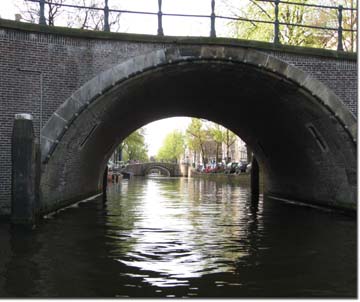 The
canals are bridged by low, narrow bridges, which can make navigation
difficult. We then spent some time
looking for Sara’s Pancake House, which turned out to be in the only
direction we did not explore.
The
canals are bridged by low, narrow bridges, which can make navigation
difficult. We then spent some time
looking for Sara’s Pancake House, which turned out to be in the only
direction we did not explore.
We passed the royal residence, which is
under renovation. This must be our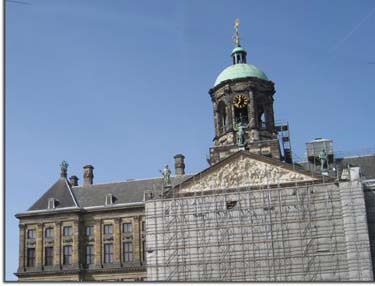 curse, as practically everyplace we have gone, the palaces have been
under repair.
curse, as practically everyplace we have gone, the palaces have been
under repair.
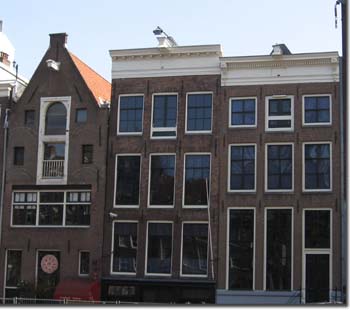 Then into the Anne Frank
House, for a sobering moment on
experiences in occupied
Then into the Anne Frank
House, for a sobering moment on
experiences in occupied
What did we learn today? Only
about 3% of all housing is owner occupied.
The Dutch did not invent the windmill – they did invent the
movable windmill head, this allowing the sails (blades) to be turned so
as to catch the most wind. The narrow Dutch houses
are taxed on frontage along the canal.
If you have a house on a corner, you get hit twice.
Bikes abound.
Parking is difficult; they are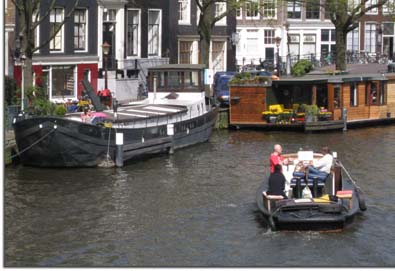 building a subway which is way over
budget. While heavier, new houses
are on 30 meter concrete pilings, everyone else is on wood pilings, which run down maybe 15 meters.
This makes it imperative that water levels be maintained so that the
pilings stay under the surfact (to block rot) but the water level below
the housing level. The streets were crowded, with people
are all over the place. It is a sunny Sunday. Everyone was
out enjoying it, as the area generally gets over 200 days of grey sky.
building a subway which is way over
budget. While heavier, new houses
are on 30 meter concrete pilings, everyone else is on wood pilings, which run down maybe 15 meters.
This makes it imperative that water levels be maintained so that the
pilings stay under the surfact (to block rot) but the water level below
the housing level. The streets were crowded, with people
are all over the place. It is a sunny Sunday. Everyone was
out enjoying it, as the area generally gets over 200 days of grey sky.
April 11
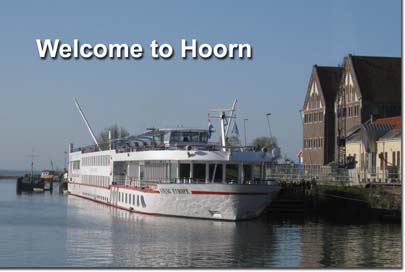 We
sailed early this morning for
We
sailed early this morning for
The second name from here was Jan Pieterzoon, who helped found 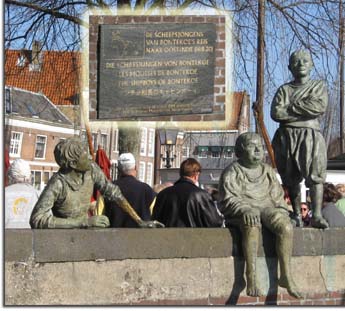
There are also three children’s book heroes, displayed as bronze sculptures. Apparently The Shipboys of Bontekoe are well known, although I must confess to never having heard of them.
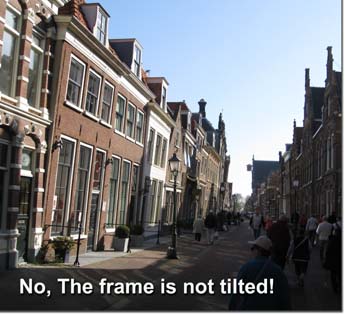 The town itself has a population of about 70,000, but you
certainly wouldn’t know it from our morning tour.
Things in the residential district were pretty quiet.
The houses generally date from about 400 years ago (1600), and
have been restored and rebuilt in the old style.
Many had wooden frames, and as a result, are leaning quite a bit.
There are a few nice details here, in frames, lintels and doors, and you
get a sense of the age of the place, by examining some of the corner and
builder's date stones.
The town itself has a population of about 70,000, but you
certainly wouldn’t know it from our morning tour.
Things in the residential district were pretty quiet.
The houses generally date from about 400 years ago (1600), and
have been restored and rebuilt in the old style.
Many had wooden frames, and as a result, are leaning quite a bit.
There are a few nice details here, in frames, lintels and doors, and you
get a sense of the age of the place, by examining some of the corner and
builder's date stones.
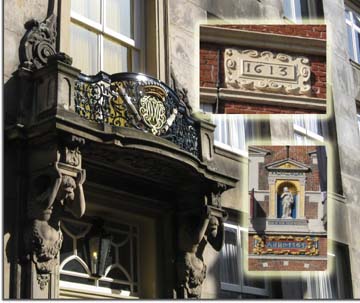
I thought that doors were of interest. They were all painted in a high gloss enamel, which made things shine and sparkle in the morning sunlight.
Initially, visitors are greeted with a nice defensive tower,
which also had a lighthouse.
While the city was supposed to have been walled, I certainly
didn’t see any remnants of the structure except the tower.
There were the usual canals and brick streets, and the usual
abundance of bicycles.
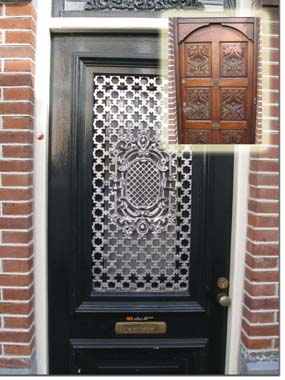 The
bikes are all pretty substantial, single speed machines.
I supposed riding on the flat, on bricks, requires a sturdy
machine. And people are all
sitting up on these – none of this bending over racing style.
These are utilitarian; get me from point A to point B devices.
Some of the doors are pretty intricate, with what appears to be
hand carving. The central
square has Cheese House, which was a former hospital.
The downtown was bustling and vibrant, with lots of shops; a
clear contrast to the sleepy residential district.
We had a couple of libations in a street café (surprised?), and
then headed back to the shop in the late afternoon.
Tonight is a wooden shoe demonstration.
I’ll reserve judgment.
Dinner – high hilarity, with a great group of people.
I didn’t make the wooden shoe gig, as was helping yet another
woman with her Smartphone.
The
bikes are all pretty substantial, single speed machines.
I supposed riding on the flat, on bricks, requires a sturdy
machine. And people are all
sitting up on these – none of this bending over racing style.
These are utilitarian; get me from point A to point B devices.
Some of the doors are pretty intricate, with what appears to be
hand carving. The central
square has Cheese House, which was a former hospital.
The downtown was bustling and vibrant, with lots of shops; a
clear contrast to the sleepy residential district.
We had a couple of libations in a street café (surprised?), and
then headed back to the shop in the late afternoon.
Tonight is a wooden shoe demonstration.
I’ll reserve judgment.
Dinner – high hilarity, with a great group of people.
I didn’t make the wooden shoe gig, as was helping yet another
woman with her Smartphone.
April 12
The wonderful weather left us today, to be replaced with rain showers. However, that did not stop us, so off on the buses we went.
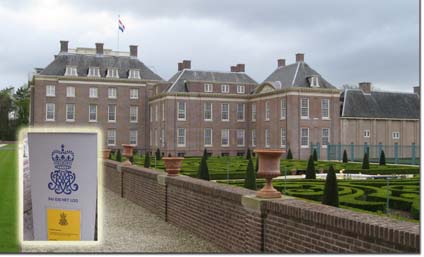 First,
we headed out to the
First,
we headed out to the
The grounds cover about 4,000 hectares,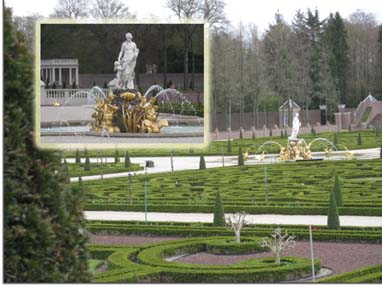 complete with gardens
that resemble a miniature
complete with gardens
that resemble a miniature
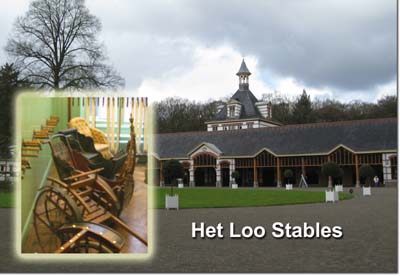 The
royal stables contain a collection of cars and carriages, including
children's carriages and pull toys.
The
royal stables contain a collection of cars and carriages, including
children's carriages and pull toys.
I have no photos of the palace, as picture taking was not allowed. It was a typical small palace, but you’ll have to take my word for it. I wonder, when I see these things: How did people really live? Get up, have a cup of coffee, read the Wall Street, decide to invade a country, impose a new tax? What?
At any rate,
that took until Noon, when it was back to the ship, and the usual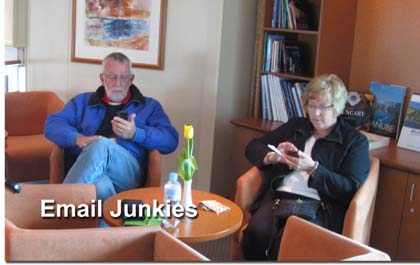 cruise
eating contest. We again
tried to check our email, but with mixed results.
cruise
eating contest. We again
tried to check our email, but with mixed results.
The same guide we had in the morning took over for a tour of the grounds that were fought over in the Battle Arnhem. This ten day battle, in September of 1944, was a massive Allied defeat, and a real blot on the military career of Field Marshall Montgomery. In a nutshell, here is what transpired. I had a great deal of help here from Dan. While I remembered the basics, Dan former history teacher and old movie buff, filled in the particulars before we arrived on site.
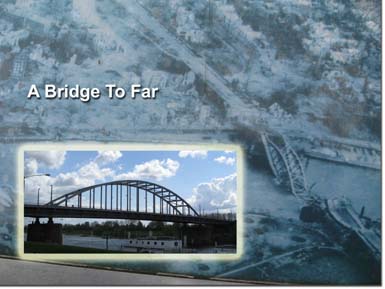 The Allies landed
on the Normandy beaches in June, ’44.
The forward momentum stalled out at the border of
The Allies landed
on the Normandy beaches in June, ’44.
The forward momentum stalled out at the border of 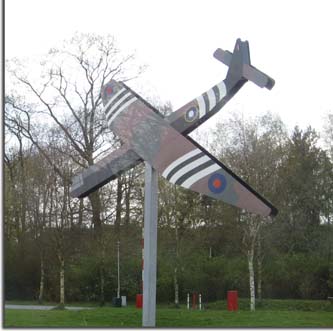 northern approaches to a major
northern approaches to a major 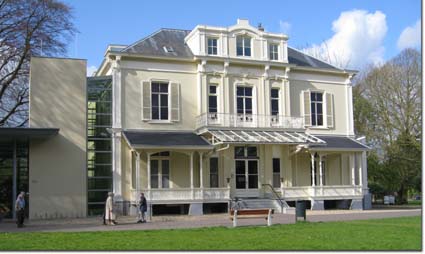 Some
say the failure prolonged war.
Others say the
Some
say the failure prolonged war.
Others say the
Our final stop was a sobering visit to the wartime cemetery,
where many of the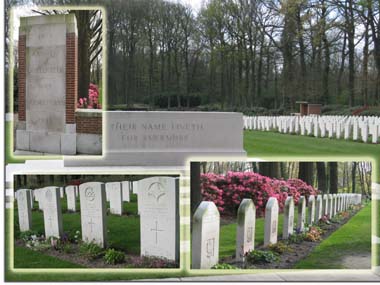 victims were buried – many unknown.
victims were buried – many unknown.
As usual, the droning guide, the vibration of the bus, put most
of us into deep slumber.
But it was back to the ship, dinner, and a folk dancing exhibition.
Later. Walking down
to the lounge, I ran into Dan, who had just come back from a brief walk
into the town of
April 13
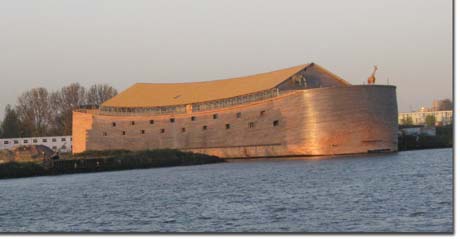 The
sun was out again today, as we sailed up the river to
The
sun was out again today, as we sailed up the river to
Dordrecht is an important traffic hub in the 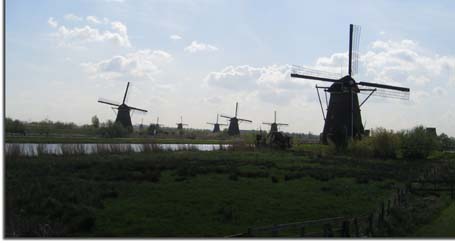 building concerns, including construction of riverboats, and major
private yachts. It is also
home to a UNESCO site, the Windmills of the Kinderdijk.
There are 19 mills remaining in this small area.
building concerns, including construction of riverboats, and major
private yachts. It is also
home to a UNESCO site, the Windmills of the Kinderdijk.
There are 19 mills remaining in this small area.
Here is the story of the Dutch windmills.
While the Dutch did not invent the windmill, they invent
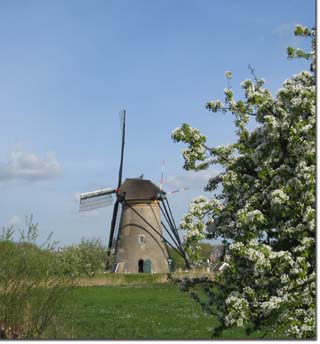 the
rotating windmill head, thus allowing the sails of the mill to be
directed in any direction so as to capture optimum wind flow.
Originally used to power granaries, and lumber mills, the power
of the mills was eventually turned to use as water pumping devices.
In order to reclaim marshy coastal lands, the Dutch built a
series of feeder canals in fertile, low lying lands.
By using berms and series of sluiceways, the water could be
channeled out to the river and then to the sea at low tide.
The berms kept the high tide water from flowing back into the
drained areas. The drained
lands started to settle, and the berms had to be built higher, and
eventually, settlement became so much that pumps were needed to get the
water out to the higher level rivers and sea.
Enter the windmill, with scoop wheels affixed externally to the
mill. The mills in this
area were built in 1738 – 1761.
The drainage canals fed two reservoirs, one higher than the
other. One set of mills
would pump water up a step to the next reservoir, while the second
pumped the water out to the river or sea.
This step procedure (or multi-stage pumping) is still utilized in
pump and water management situations today.
The windmill vanes drive an upper wheel gear, which in turn
drives an upper and lower pinion, set on the kingpost.
The lower pinion drives a water wheel which scoops the water up
(no more than 1 meter) and into the reservoir.
A hinged door, called the watch door, keeps the water from
flowing back should the mill stop.
the
rotating windmill head, thus allowing the sails of the mill to be
directed in any direction so as to capture optimum wind flow.
Originally used to power granaries, and lumber mills, the power
of the mills was eventually turned to use as water pumping devices.
In order to reclaim marshy coastal lands, the Dutch built a
series of feeder canals in fertile, low lying lands.
By using berms and series of sluiceways, the water could be
channeled out to the river and then to the sea at low tide.
The berms kept the high tide water from flowing back into the
drained areas. The drained
lands started to settle, and the berms had to be built higher, and
eventually, settlement became so much that pumps were needed to get the
water out to the higher level rivers and sea.
Enter the windmill, with scoop wheels affixed externally to the
mill. The mills in this
area were built in 1738 – 1761.
The drainage canals fed two reservoirs, one higher than the
other. One set of mills
would pump water up a step to the next reservoir, while the second
pumped the water out to the river or sea.
This step procedure (or multi-stage pumping) is still utilized in
pump and water management situations today.
The windmill vanes drive an upper wheel gear, which in turn
drives an upper and lower pinion, set on the kingpost.
The lower pinion drives a water wheel which scoops the water up
(no more than 1 meter) and into the reservoir.
A hinged door, called the watch door, keeps the water from
flowing back should the mill stop.
These mills were also homes, as the operator (the miller) had to
be ready 24/7 to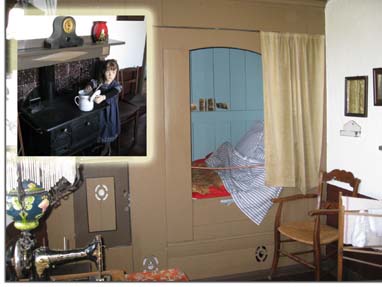 make certain that the sails were correctly set, and to
turn the pumping action on and off according to need.
The pumping power eventually moved to steam, then to diesel
electric or straight electric propulsion. These
windmills are still operational, and can be used in the event that the
electric pumps stop working.
The pumping stations can lift as much as 1,500,000 liters per
minute. The battle against
the water continues.
make certain that the sails were correctly set, and to
turn the pumping action on and off according to need.
The pumping power eventually moved to steam, then to diesel
electric or straight electric propulsion. These
windmills are still operational, and can be used in the event that the
electric pumps stop working.
The pumping stations can lift as much as 1,500,000 liters per
minute. The battle against
the water continues.
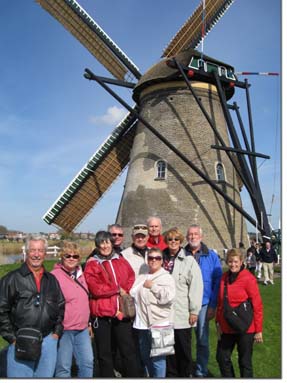 And
just to show you that we were actually on site, here we are, all happy
in the morning sun.
And
just to show you that we were actually on site, here we are, all happy
in the morning sun.
The Dutch still use the wind, although now it is with Vestra wind turbines, generating electricity. It is estimated that if the pumps were to shut down, the land would revert to water filled march in as little as 3 months. Then it was back to the ship and another favorite pastime, lunch.
I should mention the tree screens. Everywhere we went, we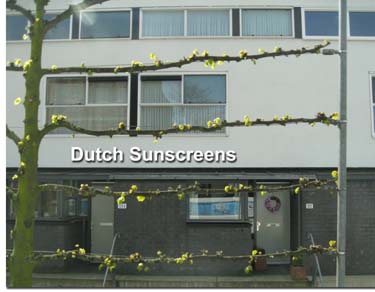 saw trees, tied into this screening lattice. The Dutch use the
leaves to form a sun screen. Personally, I wouldn't think there
would be enough sun to worry about, but we saw this implementation
everywhere.
saw trees, tied into this screening lattice. The Dutch use the
leaves to form a sun screen. Personally, I wouldn't think there
would be enough sun to worry about, but we saw this implementation
everywhere.
This will be an afternoon of R&R.
We were treated to passing coastal ships carrying bulk, containers and
coastal tankers. Tonight
and tomorrow, we are in
April 14
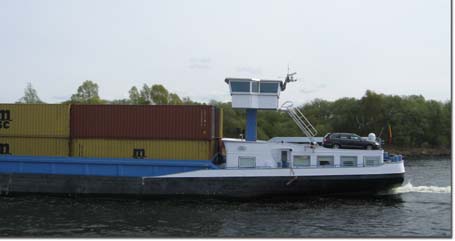 The day dawned with more passing coastal river traffic. Note the
raised pilot house, which is necessary for passing under low bridges.
The car is used in port, as the captain and his family live on board.
The day dawned with more passing coastal river traffic. Note the
raised pilot house, which is necessary for passing under low bridges.
The car is used in port, as the captain and his family live on board.
Today was our day in 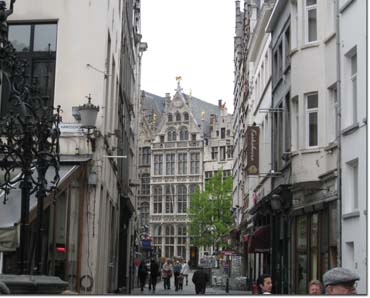 seawalls along the coast.
There are actually two countries here, as the north is aligned
culturally with
seawalls along the coast.
There are actually two countries here, as the north is aligned
culturally with
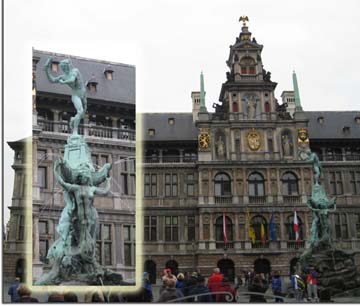 Our day started with
a walking tour. While the
girls took a bus and toured more of the Antwerp area then a walking tour
of the older part of town. We manly men took the extended walking tour.
As a result we walked though the old red light district (now
moved to be closer to the docks on the 89 mile long harbor) and many
refurbished apartments and inner garden courtyards.
Our day started with
a walking tour. While the
girls took a bus and toured more of the Antwerp area then a walking tour
of the older part of town. We manly men took the extended walking tour.
As a result we walked though the old red light district (now
moved to be closer to the docks on the 89 mile long harbor) and many
refurbished apartments and inner garden courtyards.
We ended up
in the old town square, with the statue of Brabo, the man who slay the river dragon
and threw his hand in the river, thus founding
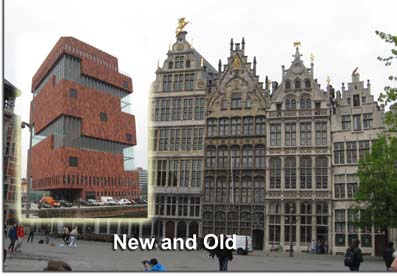
All along we saw the new – as evidenced by this new museum, representing waves and containers - to the old, with stepped false fronts and brickwork.
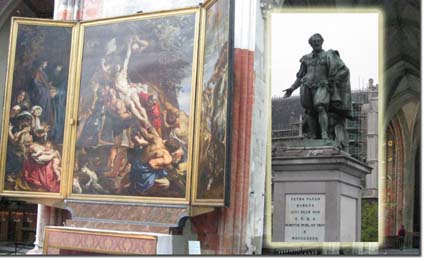 A highlight was the Cathedral of Our Lady, which had contained
some Paul Rubens paintings. The
interior is pretty. although I suspect that it is kept as a torurist
showpiece. If you looked closely, wear and tear were evident.
A highlight was the Cathedral of Our Lady, which had contained
some Paul Rubens paintings. The
interior is pretty. although I suspect that it is kept as a torurist
showpiece. If you looked closely, wear and tear were evident.
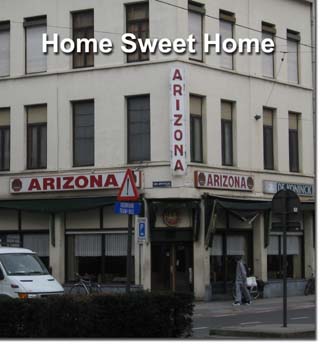
We went back to the ship. We did pass by this little slice of home, but did not stop.
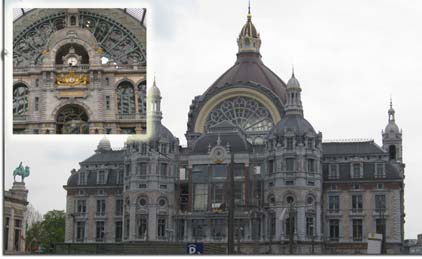 Later, we were all pretty restless, so the the four guys walked back to town to
see the railway station, one of the grandest in
Later, we were all pretty restless, so the the four guys walked back to town to
see the railway station, one of the grandest in
There is
much to like about the lifestyle and the general feeling in
April 15
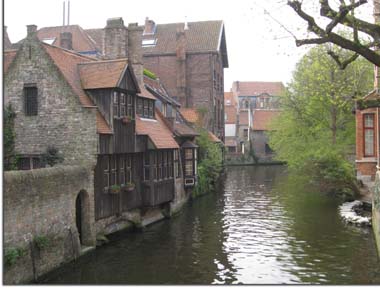 If
it is the 15th, it must be – Brugge.
Entry is through the port city of
If
it is the 15th, it must be – Brugge.
Entry is through the port city of
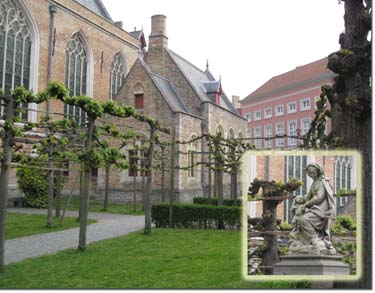 Originally, Brugge was a port city, but the harbor silted up, and
the city saw a slow, gradual decline.
This actually proved to be a saving grace for the residents, as
they had no money for urban renewal, and the city remained.
That lack of funding was the saving grace, as the residents were
unable to destroy the inherent beauty.
That of course, led to a huge tourist trade, with an abundance of
tourist shops, restaurants, tours by horse and canal boat.
The city sees roughly six million tourists a year, and this day
was no exception. The place
was packed, and frankly, a bit much.
Is it pretty, of course.
Is it a great example of a European walled city?
You bet. Was I
really impressed? Well, not
so much. I sort of felt
like, been there, done that.
There are a bunch of these walled cities in
Originally, Brugge was a port city, but the harbor silted up, and
the city saw a slow, gradual decline.
This actually proved to be a saving grace for the residents, as
they had no money for urban renewal, and the city remained.
That lack of funding was the saving grace, as the residents were
unable to destroy the inherent beauty.
That of course, led to a huge tourist trade, with an abundance of
tourist shops, restaurants, tours by horse and canal boat.
The city sees roughly six million tourists a year, and this day
was no exception. The place
was packed, and frankly, a bit much.
Is it pretty, of course.
Is it a great example of a European walled city?
You bet. Was I
really impressed? Well, not
so much. I sort of felt
like, been there, done that.
There are a bunch of these walled cities in
The church played a huge factor in medieval towns, and Brugge was
no exception.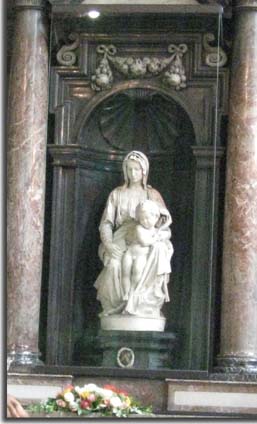 There are
plenty of massive church related structures, including asylums, a
hospital, alms houses, and the main churches.
Of note is one of the few Michelangelo statues outside of
There are
plenty of massive church related structures, including asylums, a
hospital, alms houses, and the main churches.
Of note is one of the few Michelangelo statues outside of
Visitors also get to see nice gardens, a canal system (hey folks, lets increase our revenue stream with canal boat rides) and the usual Flemish stepped gabled houses, built in the Dutch style – narrow, deep and high. We were told that the stepping arrangement is called "Steps to Heaven." It is an apropos title, as the structure does resemble a staircase climbing into the sky. Admittedly, some of the brickwork and ornamentation was quite lovely.
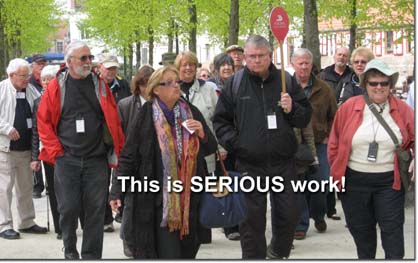 Paul was unable to get his
QuietVox to function correctly, so
took on a new duty as the "Carrier of the Sign" for the tour guide so he
could hear her commentary.
I think he did it to get a discount on his next cruise!
The four couples took the extended package today, so we had
roughly three hours in which to explore the
Paul was unable to get his
QuietVox to function correctly, so
took on a new duty as the "Carrier of the Sign" for the tour guide so he
could hear her commentary.
I think he did it to get a discount on his next cruise!
The four couples took the extended package today, so we had
roughly three hours in which to explore the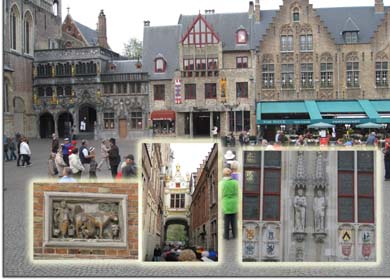 area.
First, we had lunch of Belgian waffles in an Iranian café (go
figure) and then took a canal boat ride, which gave us an additional
perspective on the old bridges, and houses of the city.
At this point it was shopping time, and we did our level best to
help lift the Belgian economy through the purchase of tapestry and lace.
area.
First, we had lunch of Belgian waffles in an Iranian café (go
figure) and then took a canal boat ride, which gave us an additional
perspective on the old bridges, and houses of the city.
At this point it was shopping time, and we did our level best to
help lift the Belgian economy through the purchase of tapestry and lace.
 And as usual, we ended up in street cafes, watching the 15,000 of
our closest personal friends wander
And as usual, we ended up in street cafes, watching the 15,000 of
our closest personal friends wander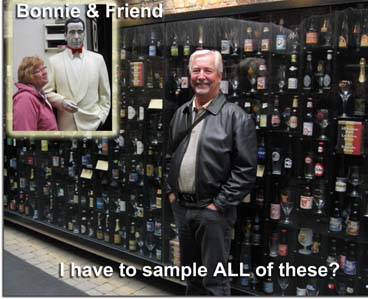 market plaza, and sampling the local
Belgian beers, of which there are a large number.
Eventually, it was time to head back to the boat (along with
another hours nap) and the start of the evening.
market plaza, and sampling the local
Belgian beers, of which there are a large number.
Eventually, it was time to head back to the boat (along with
another hours nap) and the start of the evening.
And we finally
saw tulips. We have seen
the windmills, and now the tulips.
Hence the Tulips and Windmills trip designation.
April 16
 The
intrepid travelers were up and out early again this morning.
Our greeting was a hot air balloon.
We met our guide, who was a most pleasant woman, who had been
guiding for some twenty years.
I don’t know if I mentioned it, but guides have to go through a
two year educational program and obviously need to speak at least two
languages.
The
intrepid travelers were up and out early again this morning.
Our greeting was a hot air balloon.
We met our guide, who was a most pleasant woman, who had been
guiding for some twenty years.
I don’t know if I mentioned it, but guides have to go through a
two year educational program and obviously need to speak at least two
languages.
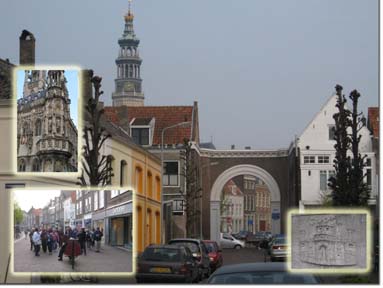 Our first stop,
in the light morning fog, was the town of
Our first stop,
in the light morning fog, was the town of
Paul was once again tasked with carrying the sign, as the guide has some visuals to display. This place was pretty much destroyed in the second world war. Barb always worries about me wandering off; a couple of the people on this tour did get sidetracked and almost missed the bus. The bus ride was an excuse for a half hour nap, but the end destination was amazing.
Today we went to the Delta Works.
This project is a storm surge suppression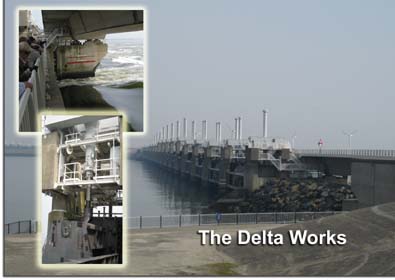 system designed to
keep the islands and lands in the Rhine, Maas and
system designed to
keep the islands and lands in the Rhine, Maas and
The government decided to so something about this. Existing dikes were repaired and built to a new height. New dams were built, but in three places, the Dutch took a revolutionary approach. Rather than try to simply wall off the water all the time, the fishing industry had to be preserved, along with the ecology of the tidal estuary. The results were massive storm surge gates.
The construction project was ambitious. The seabed was prepared with a special mat for stability, and huge concrete pylons were constructed, and floated into position by a specially built ship. The pylons were then filled with sand for weight, and rocks were carefully piled around the bases. Special steel doors were fitted between the pylons that can be lowered by hydraulic rams to close the openings in case of high water surge. This was a 25 year project, with three seawalls constructed. It was a very impressive, and a very ambitious project. We saw a film about the process, and then visited one of the gate complexes. I vaguely remember this, but had no idea as to the immensity of the project.
After that it was a ride on the bus, which meant yet another nap. There was a great deal of agricultural land to be seen along the way, and it was pointed out the when the area flooded, the water was as high as the top of the second story of buildings.
We picked up the ship in another port, had lunch, and did the
wheelhouse tour. As with
most modern ships, the ship is all pretty much computer operated, with
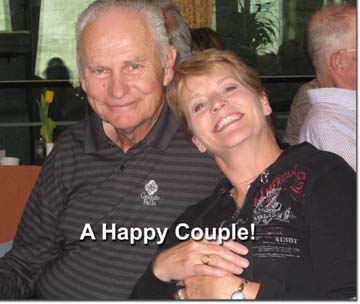 joysticks, and thrusters.
This ship is 115 meters in length, has a beam of just over 11 meters,
and yet has a draft of only 1.75 meters.
Satellite navigation has done wonders for water travel.
joysticks, and thrusters.
This ship is 115 meters in length, has a beam of just over 11 meters,
and yet has a draft of only 1.75 meters.
Satellite navigation has done wonders for water travel.
Tonight we will be in 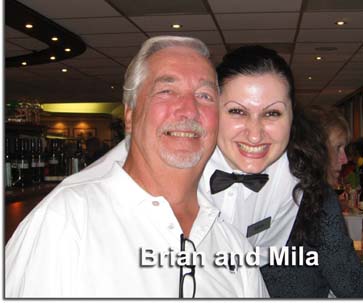
We
are coming to the end of the trip, with only a single day in
April 17
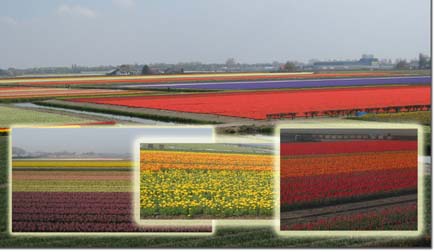 This
cruise was billed as Tulips and Windmills.
Well, we have seen the windmills.
Today was to be Tulip Day, and we were not disappointed.
We visited the
This
cruise was billed as Tulips and Windmills.
Well, we have seen the windmills.
Today was to be Tulip Day, and we were not disappointed.
We visited the
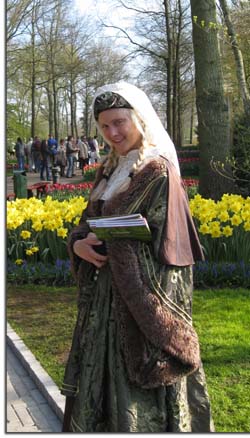 So the whole area is filled with tulip growers, who plant, wait for
the blossoms to form, and then cut off the blossoms, dig up the bulbs,
and send them all over the world.
And this brings me to our destination. In the area, was a small castle with a nice garden.
The mayor of a small local town had an idea.
Why not have the town take over the garden, turn it into a
showcase for tulips, and
So the whole area is filled with tulip growers, who plant, wait for
the blossoms to form, and then cut off the blossoms, dig up the bulbs,
and send them all over the world.
And this brings me to our destination. In the area, was a small castle with a nice garden.
The mayor of a small local town had an idea.
Why not have the town take over the garden, turn it into a
showcase for tulips, and
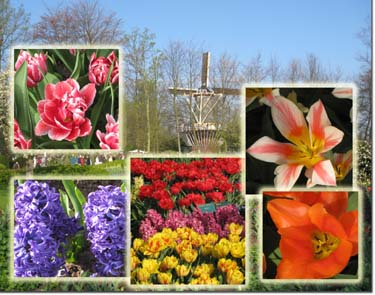 make some money.
The result if Keukenhof Gardens, a garden that is only open two
months of the year, but pulls in roughly 800,000 visitors.
After being greeted by a young woman in traditional Dutch garb, visitors will see rivers of color, special displays, and acres of
flowers. The gardens are set up
with photo spots so that visitors can get great shots with lots of color
in the background. There is every type of flowering bulb
imaginable, as is evidenced by some of these photos. The garden
features
make some money.
The result if Keukenhof Gardens, a garden that is only open two
months of the year, but pulls in roughly 800,000 visitors.
After being greeted by a young woman in traditional Dutch garb, visitors will see rivers of color, special displays, and acres of
flowers. The gardens are set up
with photo spots so that visitors can get great shots with lots of color
in the background. There is every type of flowering bulb
imaginable, as is evidenced by some of these photos. The garden
features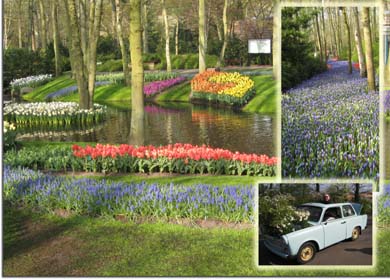 music,
food, and of course, bulbs to purchase and ship home.
It was very, very impressive.
The five of us were given free rein, and we saw plenty of
beautiful sights.
music,
food, and of course, bulbs to purchase and ship home.
It was very, very impressive.
The five of us were given free rein, and we saw plenty of
beautiful sights.
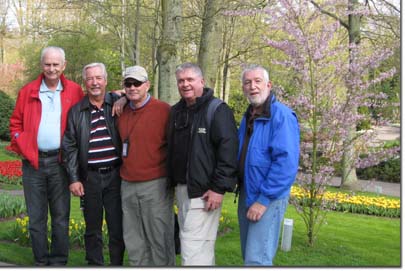 We
all napped on the bus ride back into
We
all napped on the bus ride back into 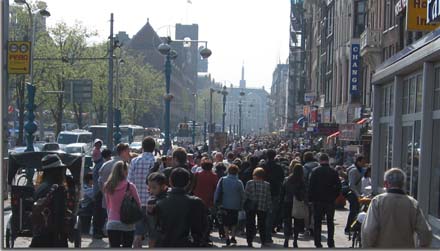
I
like